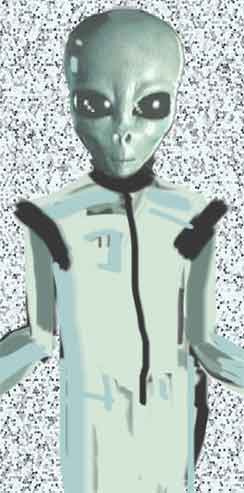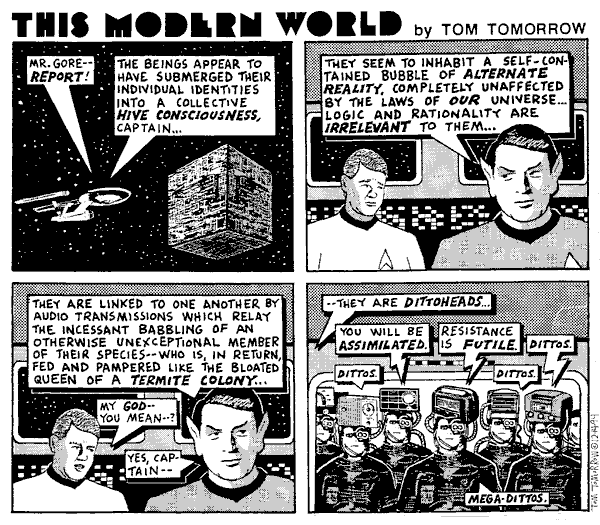Sparky: Attention All You “Rove Truth Squaders!” And is it yet Miller Time? The New York Times' Bill Keller will show us Sunday ...
 GOP's TOP TRAITOR
GOP's TOP TRAITOR Karl Rove, president
George W. Bush's chief political advisor
AKA “Turd Blossom”
Bush administration mishandling of pre-war intelligence
Background on the Plame Investigation
Video
Federal prosecutors have accepted an offer from presidential adviser Karl Rove to give eleventh-hour testimony in the case of a CIA officer's leaked identity but have warned they cannot guarantee he won't be indicted, according to people directly familiar with the investigation.
WHITEHOUSE's DEN OF TRAITORS MOST LIKELY CANDIDATE TO DO AN "POINTDEXTER" FOR THE BUSH CRIME CLAN

“Judy and "Scooter" sitting in a tree - KAY EYE ESS ESS EYE EN GEE ... !?”
Miller met with an unnamed government official — later revealed to be "Scooter" Libby, Vice President Cheney's Chief of Staff — on July 8, 2003, two days after former ambassador Joseph Wilson published an Op-Ed in the Times criticizing the Bush administration for "twisting" intelligence to justify war in Iraq. (Plame's CIA identity was revealed by political commentator Robert Novak on July 14, 2003.) ...
On September 29, 2005, after spending 86 days in jail, Miller was released after a telephone call with Lewis Libby. He had reaffirmed a release of confidentiality that he had given her a year earlier that she had already known about. She testified at Fitzgerald's Plame Case hearings the following day, September 30th. BBC News Report.
I give you the full article knowing some of you'd not click a link to read it ...
Washington Post: Leonnig & VandeHei: Rove to Testify Again in Grand Jury's CIA Leak ProbeProsecutor's Warning That Bush Adviser Could Be Indicted Suggests New Information May Have EmergedWashington Post Staff Writers: Carol D. Leonnig and Jim VandeHei
Friday, October 7, 2005; A04
White House Deputy Chief of Staff Karl Rove will again testify to a grand jury that is in the final stages of investigating whether senior Bush administration officials illegally leaked the identity of covert CIA operative Valerie Plame to the media more than two years ago, a source familiar with the arrangement said yesterday.
Special prosecutor Patrick J. Fitzgerald contacted Rove last week to seek his fourth appearance before the grand jury -- but warned Rove's lawyer that he could not assure that Rove would not be indicted, according to the source. Rove could appear as early as today, when the grand jury is next scheduled to meet.
Fitzgerald's request -- which comes just weeks before the grand jury term is set to expire on Oct. 28 -- suggests that new information has come to light in other witness testimony, or other questions remain that Rove needs to address, according to lawyers who have been involved in the case.
Rove's lawyer, Robert Luskin, said in an interview yesterday that Rove has not been notified that he is a target of the investigation, and does not fear testifying despite Fitzgerald's warning. Luskin declined to say whether he knows the topics Fitzgerald wants to question Rove about.
"Mr. Fitzgerald has affirmed to me that he has made no charging decisions, that he believes Karl continues to cooperate fully with the investigation, but beyond that, I don't want to comment at all about any communications with Mr. Fitzgerald's office," Luskin said.
A source close to Rove said Bush's chief political adviser and his legal team are now genuinely concerned he could face charges. But, the source said, his lawyers are hoping that Fitzgerald's warning of the chance of indictment is simply the move of a conservative, by-the-book prosecutor wrapping up a high-profile investigation. Prosecutorial guidelines require prosecutors to warn witnesses before they appear before a grand jury if there is a chance they could face criminal charges.
For the past 22 months, Fitzgerald has been investigating whether any Bush administration officials knowingly revealed Plame's identity in July 2003 as retaliation for public criticism by her husband, former ambassador Joseph C. Wilson IV, of the government's case for war in Iraq.
On July 6, Wilson contended in an opinion piece that administration claims that Iraq was trying to obtain nuclear materials in Niger were false. Wilson had been sent to the African nation by the CIA to investigate the claims. Eight days later, on July 14, Plame's name and CIA employment appeared in a syndicated column by Robert D. Novak.
Rove has testified that he talked with two reporters about Plame in that time period, but only referred to her as Wilson's wife and never supplied information about her status as an undercover CIA operative. Vice President Cheney's chief of staff, I. Lewis "Scooter" Libby, also testified that he discussed Plame with at least two reporters but said that he, too, never mentioned her name or her covert status, according to lawyers in the case.
The news of Rove's upcoming testimony comes at one of the more difficult moments of the Bush presidency. In recent months, Bush has faced steady criticism for his handling of Iraq, gas prices and Hurricane Katrina. Most recently, a number of prominent conservatives who have backed Bush since 2000 have been sharply critical of his nomination of Harriet Miers to the Supreme Court.
Bush spokesman Scott McClellan said the White House would not comment on the probe.
"That's an ongoing investigation . . . and the president directed that we cooperate fully with that investigation," he said. "As part of cooperating fully, that means not commenting on it from here."
As recently as a week ago, people familiar with Rove's role in the affair said they believed he was in the clear because, after Time magazine reporter Matt Cooper testified in July about his conversation with Rove, Rove had not heard back from Fitzgerald.
Rove offered then to come back and answer any questions that might arise from Cooper's testimony, Luskin has said.
It is highly unusual for a person who has any risk of being indicted in a white-collar case to offer to go before the grand jury, say veteran defense lawyers and former prosecutors. But the rare exceptions, they say, are almost always high-profile figures and politicians. Public figures can expect that an indictment will end their careers, and that refusing to cooperate in an investigation could do the same, criminal lawyers said.
A witness who has already appeared several times may be recalled to explain why earlier answers appear to conflict with accounts of other witnesses, said two former prosecutors. Or the prosecutor may simply want to inquire about new topics that have arisen in the investigation.
Under Justice Department guidelines, prosecutors must provide witnesses the opportunity to testify again if they want to recant previous testimony that may have been false. That does not necessarily prevent a prosecutor from bringing charges but can be part of that person's defense.
Besides Cooper, at least two other people have testified before the grand jury since Rove last answered questions: New York Times reporter Judith Miller, who was questioned after initially refusing to appear and serving 85 days in jail, and Rove's secretary.
Under an agreement with Fitzgerald, Miller's testimony last Friday focused on her conversations with Libby. Libby's lawyer, Joseph Tate, did not return telephone calls seeking comment yesterday.
Rove's secretary was questioned about why a phone call from Cooper to Rove in 2003 was not recorded in White House phone logs, according to sources familiar with the probe. She reportedly explained that Cooper called the main switchboard and his call was not logged because it was rerouted to Rove's office.
One apparent conflict between Rove's and Cooper's accounts centers on Rove telling the grand jury that he and Cooper talked primarily about welfare during their conversation, according to lawyers familiar with Rove's account. Cooper has said the grand jury asked him repeatedly about the welfare portion of his discussion with Rove, but Cooper said that, although he left a message for Rove about welfare reform, their conversation that day centered on Wilson.
Randall Eliason, former chief of public corruption prosecutions in the U.S. attorney's office in Washington, said it is difficult to speculate about Rove's possible exposure.
"Obviously, some more questions were raised since the last time he testified that Fitzgerald wants to answer," Eliason said. "It would be unusual for Rove to go back in if he felt he was going to be indicted."
A notable example of a public figure voluntarily going before a grand jury despite the risk of indictment is Sen. Charles S. Robb (D-Va.). He had been notified in 1992 that he was a target of an investigation into illegal wiretapping of a political opponent. When he learned the Justice Department had authorized bringing charges against him, his attorney pressed to let him reappear before the grand jury. He was not indicted.
Staff writers Walter Pincus and Susan Schmidt contributed to this report. © 2005 The Washington Post Company - cite links and fair use
New York Times reporter sent to jail in leak caseJuly 6, 2005 On Wednesday, in a case that toes the line between a search for the source of criminal activity and the right to freedom of the press, a New York Times reporter was jailed after she refused to reveal her confidential source to a grand jury investigating the leak of a covert CIA operative's name to the media.
Chief U.S. District Judge Thomas Hogan ordered correspondent Judith Miller to jail immediately and said she must stay there until she agreed to testify or for the rest of the grand jury's term, which lasts through October.
"If journalists cannot be trusted to keep confidences, then journalists cannot function and there cannot be a free press," she said in the courtroom.
"I do not make confidential pledges lightly, but when I do I must honor them. If I do not, how can I expect people to accept my assurances."
"Your honor, in this case I cannot break my word just to stay out of jail," Miller told the judge during the hearing which lasted about an hour.
Miller also noted that she did not consider herself to be above the law and that she had thought long and hard over the July 4 Independence Day holiday about her decision.
She said her decision was necessary to help ensure an independent free press.
Judy Miller connects to the Iraq War — She's one of the reporters who have sold out to the current administration ... (as per her Wikipedia article)

Miller has come under heavy criticism for her reporting on whether
Iraq had
weapons of mass destruction (WMD). On
September 7,
2002, Miller and
Times reporter
Michael R. Gordon reported the interception of metal tubes bound for Iraq. Her front page story quoted unnamed "American officials" and "American intelligence experts" who said the tubes were intended to be used to enrich nuclear material, and cited unnamed "Bush administration officials" who claimed that in recent months, Iraq had "stepped up its quest for nuclear weapons and has embarked on a worldwide hunt for materials to make an atomic bomb."
[4] Miller added that "Mr. Hussein's dogged insistence on pursuing his nuclear ambitions, along with what defectors described in interviews as Iraq's push to improve and expand Baghdad's chemical and biological arsenals, have brought Iraq and the United States to the brink of war." Although Miller conceded that some intelligence experts found the information on Iraq's weapons programs "spotty," she did not report specific and detailed objections, including a report filed with the US government more than a year before Miller's article appeared by retired Oak Ridge National Laboratory physicist, Houston G. Wood III, who concluded that the tubes were not meant for centrifuges.
Shortly after Miller's article was published, Condoleezza Rice, Colin Powell and Donald Rumsfeld all appeared on television and pointed to Miller's story as a partial basis for going to war. Subsequent analyses by various agencies all concluded that there was no way the tubes could have been used for uranium-enrichment centrifuges.
Miller would later claim, based only on second-hand statements from the military unit she was embedded with, that WMDs had been found in Iraq. (NYT, 4/21/03) This again was widely repeated in the press. "Well, I think they found something more than a smoking gun," Miller said on The NewsHour with Jim Lehrer. "What they've found is a silver bullet in the form of a person, an Iraqi individual, a scientist, as we've called him, who really worked on the programs, who knows them, firsthand, and who has led MET Alpha people to some pretty startling conclusions." This story also turned out to be false. [5]
On May 26, 2004, a week after the U.S. government apparently severed ties with Ahmed Chalabi, a Times editorial acknowledged that some of that newspaper's coverage in the run-up to the war had relied too heavily on Chalabi and other Iraqi exiles bent on regime change. It also regretted that "information that was controversial [was] allowed to stand unchallenged." While the editorial rejected "blame on individual reporters," others noted that ten of the twelve flawed stories discussed had been written or co-written by Miller. [6]
Miller has reacted angrily to criticism of her pre-war reporting. In a May 27, 2004 article in Salon, published the day after the Times mea culpa, James C. Moore quoted her: "You know what," she offered angrily. "I was proved fucking right. That's what happened. People who disagreed with me were saying, 'There she goes again.' But I was proved fucking right." This quotation was originally in relation to another Miller story, wherein she indicated that trailers found in Iraq had been proven to be mobile weapons labs. That too was later shown to be untrue.
On November 11, 2004, the Times published an obituary for Palestinian leader Yasser Arafat written by Miller. Critics say it contained a number of factual errors with regard to historical context.
Arianna Huffington: “So, as the image of Judy as a principled, conscience-driven defender of the First Amendment gives way to the image of Judy wearing her "new" waiver as a fig leaf allowing her to get out and sing, the big question remains: What is she hiding? ... But her role is actually much, much more complicated than that. Any discussion of Miller's actions in Plamegate cannot leave out the key part she played in cheerleading for the invasion of Iraq and in hyping the WMD threat. Re-reading some of her prewar reporting today, it's hard not to be stunned by just how inaccurate and pumped up it turned out to be. ... Miller was also given special treatment -- even after her deeply-flawed reporting on WMD, even after the paper was forced to apologize for four of her WMD stories, even after her highly-irregular behavior while embedded in Iraq, even after she was forced off the WMD beat in hope she would quit, even after a number of her colleagues refused to share a byline with her. Even, even, even…”
Digby writes: “[I]t seems obvious now that Jeralyn was right; Judy's real issue was being asked about her other sources under oath. It looks like they came to some sort of agreement about that.”
Links
- "Karl Rove named as a source of Plame leak". Wikinews, July 3, 2005
- (Huffington Post) Miller Walks: The Plot Thickens
- (LATimes) Who is Judy Miller kidding?
- (WashPost) Miller's Big Secret
- Official statements from Miller, her editor and her publisher
- Why, Oh, Why Didn't You Return My Calls, Scooter??? - where the cartoon is from
- James Vicini "New York Times reporter sent to jail in leak case". Reuters.com, July 6, 2005
- Pete Yost "Time Reporter to Testify in CIA Leak Case". Yahoo.com, July 6, 2005
- "New York Times reporter Judith Miller testifies on exposure of CIA agent" by Bill Van Auken
- "Judith Miller" (SourceWatch entry)
- "Miller's Big Secret" by Dan Froomkin (The Washington Post, September 30, 2005)
- "Embedded Reporter's Role In Army Unit's Actions Questioned by Military" by Howard Kurtz (The Washington Post, June 25, 2003)
- "A Devil Theory of Islam" (The Nation)
- "Judith Miller and Jayson Blair" by Margaret Kimberly (Chicago Defender)
- "Judy Miller's War" by Alexander Cockburn (Counterpunch, August 18, 2003)
- "Not Fit to Print" by James C. Moore (Salon, May 27, 2004)
- "Confidentiality of Journalists' Sources Under Threat" (IFEX)
- "Rudith Miller on Judith" (The Common Ills)
- "In free-press America, it's Miller time" by Kathleen Parker
- "The Source of the Trouble", by Franklin Foer (New York Magazine, June 7, 2004)
- Pulitzer Prize-Winning Reporter Crosses The NY Times' Line of 'Strict Neutrality' (antiwar.com, May 7, 2003, republished May 27, 2004)
- (Arianna) Huffington Post continuing series on Miller's possible self-interest in nondisclosure.
- Plamegate timeline, AIPAC / Franklin Pentagon mole indictment, Niger yellowcake connections? at NewsFollowUp.com.
So why aren't Rove, Libby, Novak, et al in Leavenworth awaiting execution for being traitors? Let's ask Fitzgerald and the Whitehouse! Leave comments and let's reach a consensus. - Sparky





 Boomer
Boomer














